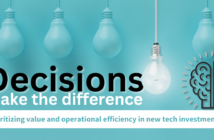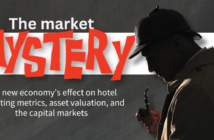How to chart a course during an asymmetric hotel-demand surge
by LARRY and ADAM MOGELONSKY
When it comes to the expected travel recovery throughout the latter half of 2021, a rising tide doesn’t necessarily raise all ships. Yes, revenge travel is very much a real entity, and it will cause many hotels that fit a certain profile to experience maximum occupancy as confidence is restored following widespread inoculation. Others, unfortunately, won’t be so lucky.
What’s critical in the months ahead is to examine what type of customers – often called ‘guest personas’ – will be more likely to travel then pivot your operations and marketing efforts to meet their specific demands. All the while, there are still numerous opportunities to deploy technologies that were advantageous to help stop the spread of COVID-19 but can now help a hotel become hyper-efficient.
LEISURE GUEST PERSONAS
As unfortunate as it is to say, Wall Street no longer reflects Main Street, and many pre-pandemic jobs aren’t ever coming back. Sadly, when the stimulus checks run dry, some malls will close as more businesses shift to online shopping and many restaurants will dog it out against lower-cost ghost kitchens for orders on food-delivery apps. Caught in the middle are the countless waiters, retailers, and store owners – the service sector that composed a substantial portion of the working class.
The first implication is that the demise of this sector means less disposable income for vacations, influencing primarily those properties in the economy, select service, and economy-scale tiers that catered to this demographic. Conversely, the professional class has only been temporarily affected by the various lockdowns. Once vaccinated, they are ready to resume their 2019 levels of travel. Understanding this macroeconomic shift will help you to adjust accordingly.
First, you must understand the lingering influences of this terrible virus. People are seeking out ‘private’, ‘secluded,’ and other types of spacious accommodations. What isn’t so obvious is the new sense of introspection that’s grown within us. While everyone enjoys a great dining experience, we’ve nevertheless become accustomed to cooking tasty meals at home; promoting your kitchenettes is thus an excellent differentiator. Speaking of in-room features, even with inoculation, many customers will be reluctant to utilize shared facilities and will opt for those properties that offer guestroom exercise programs, more elaborate bathroom or spa amenities, and other wellness-oriented upgrades.
On the technology front, contactless convenience has moved from a value-add to an expectation. As a legacy from the pandemic, your guests now demand mobile check-in and checkout, as well as the ability to book all manner of services from their phones. Developing the proper integrations to allow for a seamless connection between online requests right through to the department that renders that deliverable will increase both revenue per guest and labor productivity. Further, contactless payment solutions should be a foremost thought to this end, bearing in mind that a secure, PCI-compliant one is crucial to help minimize the rising trend of friendly fraud and blooming chargebacks.
PRE-ARRIVAL REVENUES
Given all the new hurdles travelers must go through, they will tend to pay more attention to the planning stage for any upcoming trip. Given the requirements for contact tracing and booking all experiences in advance, guests will want to ascertain the bulk of their itineraries from their own homes, making those tech-savvy hotels ripe for increased revenue. This can greatly enhance the accuracy of labor projections to lower costs and ensure that underservicing customers doesn’t become a detriment after the fact.
Consider, for instance, an in-house dining outlet. As a start, guests will want to know before arriving the new hours of operation and all the new safety measures that are in place. This alone means you need to have effective pre-stay messaging in place – either directly through your PMS or via the CRM – to decrease the burden on your guest-services agents.
Next, given the reduced number of dining tables available due to social-distancing mandates, it behooves you to prompt guests to make reservations as far ahead of time as possible so they aren’t left out once onsite and so you don’t overstaff. This requires you to investigate platforms and booking engines that can enable dining (as well as spa and other activity) purchases immediately following the room reservation. As a runner-up to this, segmented prearrival emails containing a link to an online booking portal for dining will help along with any systems that allow you to coordinate reservations entirely within the guest’s preferred SMS platform.
Lastly, to further decrease the time spent by your live agents in managing all these requests, you may want to consider utilizing a hotel-trained call center to outsource the voice channel so you don’t incur any abandonment issues – those where guest phone calls aren’t answered and the customer opts for an off-property alternative.
REMOTE WORKERS
One prominent guest persona to emerge from the pandemic is that of the digital nomad or person whose job allows them to work from anywhere (provided there’s good Wi-Fi). Heavily overlapping with the aforementioned professional class, your first task in trying to appeal to this growing cohort is to put yourself in their shoes to discern what specific services they would want to better facilitate a working-while-traveling situation.
In the room, these guests will want an ergonomic office setup – think comfortable chairs, second monitors or other inspirational business spaces available on-demand. Ideally, you would have connected rooms available or a reasonably priced suite upgrade so a worker can attend a videoconference meeting without disturbing their significant other. Readily available nearby daycare services may also be a huge plus.
This is where describing the recovery as asymmetric comes into play, as many hotels may not have the right guestroom amenities, on-premises features, or location to appeal to this group. If a pivot into this market is desired, then budget must be allocated right away for a minor PIP that will help tick all the boxes, which would otherwise be dealbreakers for these digital nomads.
Such upgrades should also encompass a keen eye toward technology. Every work-from-a-hotel or business-oriented service should be on-demand so guests can get what they want directly off their phones, with the property connecting the dots behind the scenes by having the appropriate operations management software and perhaps even a chatbot application to manage the guest communications without the need to burden a staff member.
Above all, remember that members of this hybrid travel segment will help you to build midweek occupancy, so it behooves you to develop a rate plan that will incentivize a longer length of stay. Moreover, the flexibility of remote work enables you to explore extended-stay packages. While these likely will represent lower RevPAR guests, you’re still filling rooms that may otherwise stay vacant.
SMALL GROUPS SURGE
The post-pandemic swell of transients and bleisure guests are two of the more predictable trends, but we’re all still wondering how groups will fare. Yes, numerous companies have recognized the uselessness of unending videoconferences for both collaboration and sales efforts. Everything is more effective in person, but there are now many more barriers to congregating, which can render large groups drastically more expensive and potentially infeasible.
Despite any perceived productivity losses, the reduced footprint of less rent (via remote-work policies) and fewer conferences (through the use of teleconferencing solutions such as Zoom) will continue to drive the bottom line for numerous companies. Thinking optimistically, though, revenge travel also applies to groups in that it’s been so long since many executives have assembled and they are well past due for a corporate retreat, whether that be simply for a reunion or strategic planning. Then, there are all the social events that were canceled in 2020, with members just itching for the chance to get together once the all clear is given.
“Bringing groups back won’t be easy, and you must already have a solid group program set up before demand picks up in this segment,” commented Vikram Sood, VP of Operations at Hostmark Hospitality, a hotel management group in San Diego. “Negotiations in the recovery group are going to move fast. You need to have a full sales team already in place with all the necessary demand-monitoring tools and electronic signature platforms to react in an instant or else the business will go to your competitors.”
Another significant term to understand is the hub-and-spoke nature of business meetings going forward. That is, rather than risk a national or multinational conference, companies will instead opt for hosting a smaller, televised event from the headquarters (hub) with hotels in designated markets selected as gathering points for regional offices (spoke). Such an approach requires properties to have exceptional audio-video support to smoothly run hybrid events to make multiple offices feel as one unit despite their physical separations.
Taken together, the overall argument is that the world has moved online. Those properties that thoroughly embrace technology while also developing programs to meet the post-pandemic changes in behavior will prosper while others may be left out of the money.
 Together, Larry and Adam Mogelonsky represent one of the world’s most published writing teams in hospitality, with more than a decade’s worth of material online. As the partners of Hotel Mogel Consulting Limited, a Toronto-based consulting practice, Larry focuses on asset management, sales, and operations, while Adam specializes in hotel technology and marketing. Their experience encompasses properties around the world, both branded and independent, ranging from luxury and boutique to select-service. Their work includes six books: Are You an Ostrich or a Llama? (2012), Llamas Rule (2013), Hotel Llama (2015), The Llama is Inn (2017), The Hotel Mogel (2018), and More Hotel Mogel (2020). You can reach Larry at [email protected] or Adam at [email protected].
Together, Larry and Adam Mogelonsky represent one of the world’s most published writing teams in hospitality, with more than a decade’s worth of material online. As the partners of Hotel Mogel Consulting Limited, a Toronto-based consulting practice, Larry focuses on asset management, sales, and operations, while Adam specializes in hotel technology and marketing. Their experience encompasses properties around the world, both branded and independent, ranging from luxury and boutique to select-service. Their work includes six books: Are You an Ostrich or a Llama? (2012), Llamas Rule (2013), Hotel Llama (2015), The Llama is Inn (2017), The Hotel Mogel (2018), and More Hotel Mogel (2020). You can reach Larry at [email protected] or Adam at [email protected].




